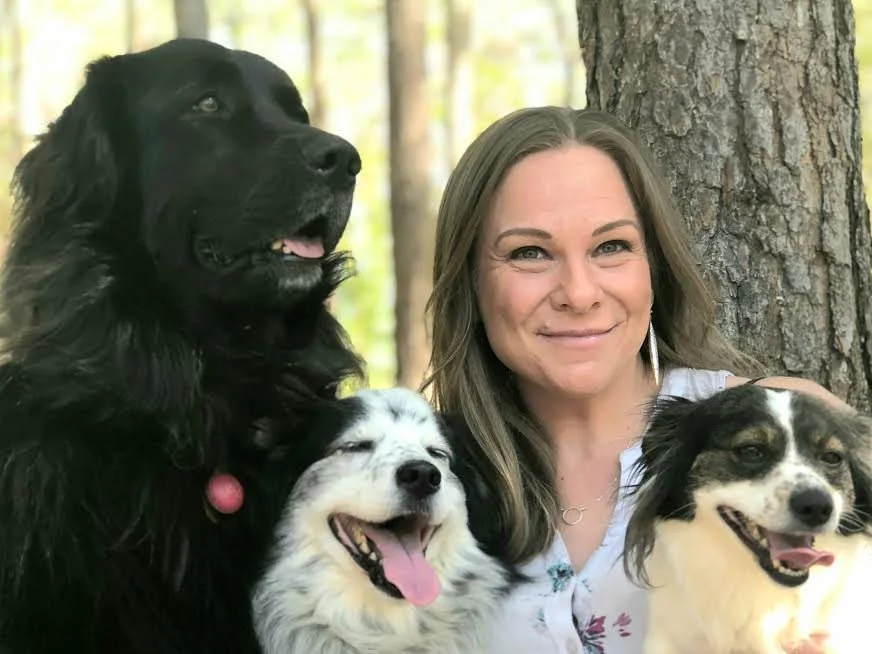Asheville Loves Dogs: The Dog Door
We have so much support from our community here at Pawsitivity, and we want to support some of our neighbors who share our philosophy about dog sentience and compassionate care. In this blog series, Asheville Loves Dogs, we are highlighting our favorite dog-friendly places, businesses, and services that make Asheville such a great place to live with a dog!
Our first interview is with Kim Brophey, owner of The Dog Door, Asheville’s holistic behavior center. We have a great relationship with Kim and her colleagues, and we value their approach and the work they do in our community. Rather than offering basic conventional training rooted in behavioristic ideas, they see the dog as a whole being and look at breed, home environment, and other factors in order to handle behaviors.
Kim grew up in Atlanta in the ‘70s and early ‘80s, when dogs were loose in the city. In the summers she would hang out with neighborhood dogs, and was fascinated with trying to understand them. The dog training world became a turn-off for her because it was focused on human ego and forcing dogs to be compliant against their will. Wanting to figure out something else to do with animals, Kim got a degree from Warren Wilson in Applied Ethology -- a field in which no one at the time had a formal education. Ethology is the study of animal behavior; applied ethology is the study of the relationship between human and animal behavior in captive and/or domesticated animal species. It asks questions such as, what is the effect of human interference for the animal? What happens to human behavior when we try to communicate with animals, manage them, study them, keep them in a zoo, and have them living in our homes?
This approach is very different from the American model, which is dominated by behaviorism -- the theory that human and animal behavior can be explained in terms of conditioning, without appeal to thoughts or feelings. Kim says, “Behaviorism is legitimate, but it’s not the whole story. I was inspired to change people’s relationships with dogs based on an understanding as opposed to a goal to manipulate.” After graduating college, she worked for two years as executive director of a sanctuary rescuing dogs, and during that time began establishing her business. Here are excerpts from our interview:
What are your main goals for dogs and their owners in your training programs?
We dislike the connotations of terms like training, obedience, and commands. We’ve coined the term “family dog mediation,” which holds everyone accountable. You are basically the parent in your relationship with your dog. You are responsible for explaining, showing, guiding, and equipping them to handle all the things they deal with as a pet dog in the modern world. It’s about understanding where they’re coming from, and coming up with a contract of terms for how we can meet everyone’s needs. The title of my book is Meet Your Dog -- it’s about meeting your companion, your partner, halfway.
How is your work different from conventional training methods?
People come in with a dog and they think the dog is doing something for one reason, but they misunderstand. They are setting up all the logistics wrong, so it communicates the opposite of what they’re trying to teach the dog. For example, we had a Greater Swiss Mountain Dog who came in aggressively frothing at the mouth at the end of the leash, lunging and barking at everyone and everything. The owner had received advice that the dog feels better if you’re not holding the leash tightly because tightness communicates tension. So she was giving the dog the full length of the leash, and the dog would aggressively charge at everybody. The owner was under many misguided perceptions about what she should do. The dog had misunderstood the presentation of animals and people in public, interpreting it as her responsibility to protect the owner from everything, because she was given so much range. The dog’s perception as a social animal was that she was being put on point: it was her job to take care of things.
Even something as subtle as arrangement of space, so that you are consistently closer to things and people than the dog is, shows the dog that you’ve got it. The dog realizes she’s not responsible to protect you from everything. The proper type of leash also makes a difference; the dog may be unintentionally lunging because of the physical design of the leash. She’s out front, feeling vulnerable and responsible, and then you correct her, which reinforces her idea that being around other people is bad.
We changed the dog’s equipment, and we showed the owner how to step up and be in charge. Every time the dog looked at a person without barking, she got a treat, rather than constant attempts to distract.
Most training involves carrots and sticks. The carrot approach tries to bribe them into compliance. The stick approach is to beat them into compliance. Instead, we change the contingencies so that the behavior is rendered unnecessary.
Once you figure out where your dog is coming from, you can answer the central question of why they’re behaving in the way you don’t want. You find the underlying motivation or need, then you set up cause and effect: “This behavior gets what you want; this does not.”
What this dog wanted was to feel safe and protected. What she learned was that mom would protect her, and that when she looked at people good things happened. Behavior changes completely when you understand and shift expectations.
I have been working for 20 years to try to shift this understanding in the industry. Many professionals from other scientific disciplines such as human psychology are saying the same thing. Behavior is a symptom: an expression of a need or underlying problem, concern, or question. It makes so much more sense to take extra time on the front end to figure out what’s going on. You have to be the parent, because dogs are not equipped to navigate the human world on their own. They need us to show them, take care of them, and make decisions for them. You want to give them every choice you can that’s appropriate, but no choice that they can’t handle. Letting them make all the choices leaves them totally naked and vulnerable: it does not help them. It’s about knowing when to step up and when to step back.
Could you briefly describe the Dog L.E.G.S. philosophy?
This is a template or a structure for what has been established science for years. There is nothing new content-wise, but L.E.G.S. is a simple way to explain the aspects of a dog’s individuality: Learning, Environment, Genetics, and Self. In any species in nature, all those things matter. It’s not all about how you raise a dog; other things affect them too. Dog L.E.G.S. gives us a checklist of stones to look under for an understanding of what’s going on with your dog.
Breed absolutely matters, because the dog’s perception of you, based on what they’ve been bred to do, is going to matter in your home. We don’t use genes as predictive, but we factor it in as a point of reference -- to know the intention of the breeders historically and what has made the breed distinctive.
As you take an inventory of the environment, you can understand what is making the dog behave a certain way. Simple changes can make a huge difference. For example, we had someone call us about their dog, who was growling at their baby. He wouldn’t bite or go after the baby. The baby would crawl to him and liked to ride on his back. Most of the time he was fine, but every now and then he would growl, then get up and walk away. First of all, this is exactly the wrong thing to do with a kid and a dog! Second, there is nothing wrong with the dog communicating discomfort and moving away. He is just letting you know, “This makes me uncomfortable.” With kids we say, “Use your words.” Dogs have snaps, barks, and growls to communicate. They are living beings, not robots.
Another example: we had a client who thought her terrier was neurotic because he was running back and forth barking at walls in her new house. He was not eating or sleeping. I visited her house and told her, “You have mice in your walls! You need to call an exterminator.” The terrier, bred for ratting, was trying to catch the mice in the walls! L.E.G.S. gives us a way to diagnose what’s going on. The E is bringing out the G, which is causing this behavior.
How do you assess whether a puppy or dog is a good match for an owner or family?
We observe puppies in a litter if we can. This gives us the most information other than genetics. We observe their dynamics with each other: who has a short fuse, who lets everything roll off. For a family with kids, we want a dog with resilience. We look at environment, schedule, touchiness (wanting to cuddle versus being independent) -- the L.E.G.S. of the situation. We start with what is genetically not likely to be a good match because of how the dog is bred to behave. Our goal is to optimize the chances for success. Generally, the most well-balanced dogs are the mixed breeds -- so mixed you can’t tell what they are primarily -- because they are more genetically well-rounded. We customize to the client’s situation, helping them know what to look for and where to look. We do in-person assessments when needed.
What is one myth about dogs that many dog owners believe?
A dangerous myth is that it’s all how you raise them. People put inordinate, unrealistic pressure on the L. “If I just did all the right things, it would work.” This ignores the force of the other three factors, and often leads to frustration. People give up prematurely, when often just simple changes are needed -- environment instead of learning, for example. The unreasonable weight the L carries makes people feel like they or their dog are failing, when a simple change would make things work.
What is one thing you wish every dog owner understood about their dog?
They are biological animals. All animals have a phenotype: all of these factors matter. We know from established science that dogs are sentient, feeling, perceptive beings with brains almost identical to humans. They deserve for us to become more aware of their experience in our lives, because they are not on this planet to be our pets and minions. That is not their purpose. Humans have genetically coerced them; they are pigeonholed into behavior and physical traits that are often against their own best interest. Dogs don’t ask to be neurotic in behavior or physical expression, or unhealthy because of how we’ve bred them. Realize that they are not just cute little puppies. Stop and ask, how would you feel? This is not inappropriate anthropomorphism, but modern science.
For more information:
Check out The Dog Door website at dogdoorcanineservices.com.
Connect on Facebook at The Dog Door.
Visit The Dog Door Store and Outfitters, home of Asheville’s official Dog Welcome Center, at
1 Battle Square, Suite 1A, Asheville, NC.
Find Kim’s book, Meet Your Dog, at meetyourdogbook.com.
(Photo credits: Title: Alyssa Graham, Kim Brophey: dogdoorcanineservices.com)

